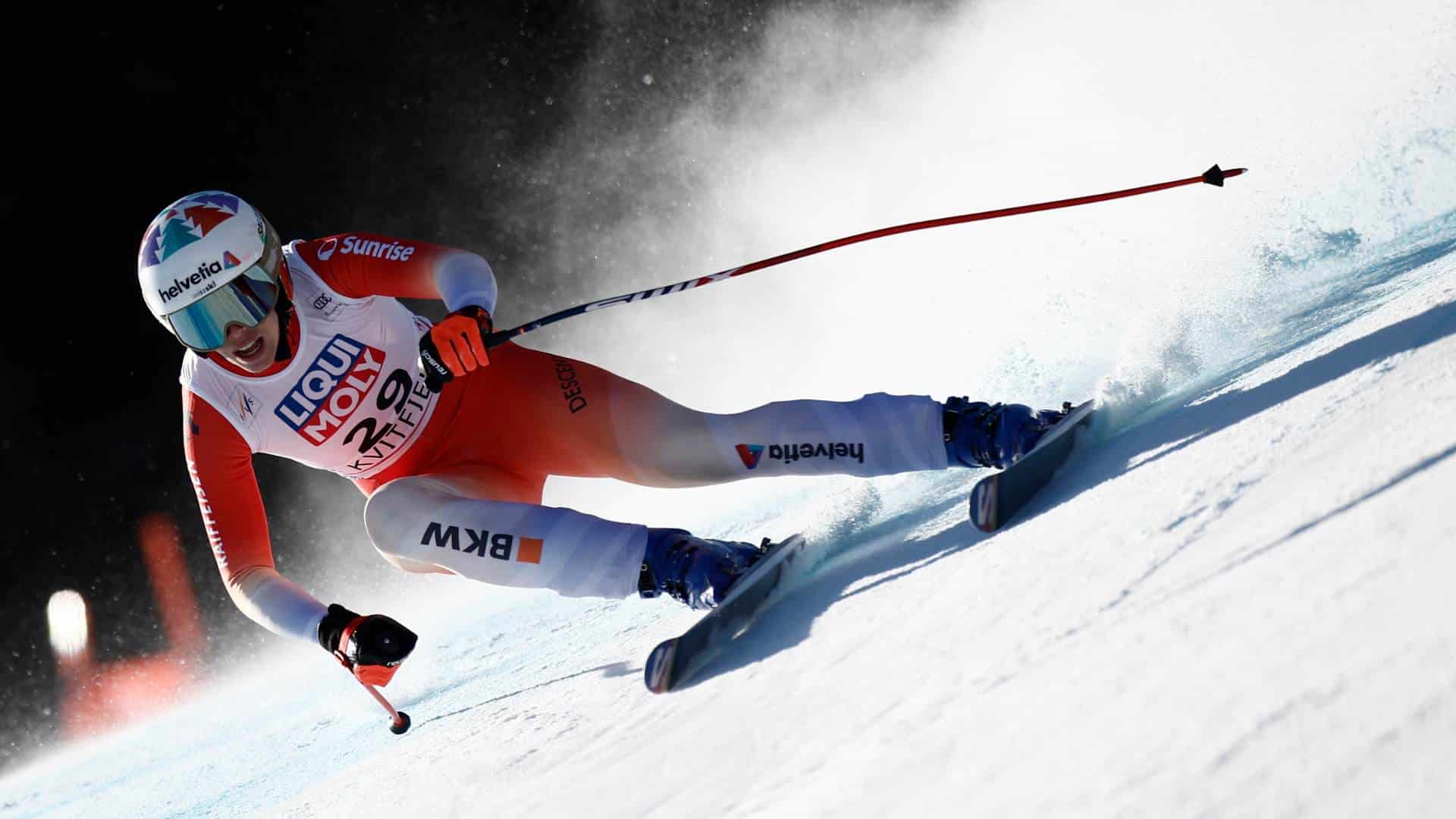With climate change snow packs are disappearing. If we don’t do something to slow it down, the idea of flying down a mountain will be a thing of the past.

Switzerland’s Michelle Gisin speeds down the course during an alpine ski, Women’s World Cup downhill, in Kvitfjell, Norway, 28 February 2025. (AP Photo/Gabriele Facciotti)
This article, by high school student Ben Smolko was produced out of News Decoder’s school partnership program. Ben is a student at the Tatnall School, a News Decoder partner institution. Learn more about how News Decoder can work with your school.
I’m in high school now, and skiing is one of my favorite things to do — but I know it’s something my grandkids may never get to experience.
Normally the bike trails underneath the chairlift would be buried under a thick blanket of snow in the winter. But as temperatures begin to rise, more and more people are beginning to see the snow fade to brown earlier than ever before. Skiing could very well become a relic of the past — an age-old sport confined to history books and old photographs.
According to a study conducted by U.S. climate scientists in 2017 and funded by the U.S. Environmental Protection Agency’s Office of Atmospheric Programs, “season length changes” due to warming winters “could result in millions to tens of millions of foregone recreational visits annually by 2050, with an annual monetized impact of hundreds of millions of dollars.”
These same scientists found that ski seasons in the United States are expected to see reductions in length, exceeding 50% in 2050 and 80% in 2090 for some locations.
The reality is that by the end of the century most resorts in the United States will have closed. While it may seem like artificial snow is the solution to this monumental problem, that is not the case. This fake snow may be able to help resorts stay afloat for the next decade or so, but it is not a viable option in the long run.
Can we make snow?
According to an article published by the American Chemical Society in 2019, snow making takes energy, mostly fossil-based, which further exacerbates the issue by contributing to more carbon emissions.
Not only are these snow makers harmful to the environment, but as temperatures begin to rise, there are less windows for snowmaking itself.
Dr. Elizabeth Burakowski, a climate scientist at the University of New Hampshire, said that snowmaking operations require temperatures that are below freezing to operate efficiently. This means that even though artificial snow can be useful in the short term, it won’t be a feasible solution in the future as the conditions needed for making that snow begin to disappear.
More importantly, artificial snow is merely a band-aid on a much larger wound. The onus is instead on ourselves to remedy this problem and not the resorts trying to scramble for answers.
Amie Engerbretson, a professional skier and climate activist, thinks that both skiers and resorts are reluctant to talk about the problem. “I think they’re scared,” Engerbretson said. “I think they’re scared of being called a hypocrite.” This fear is understandable. Many in the ski-industry rely on fossil-fuel powered lifts and snowmobiles and travel to enjoy the sport they love.
Let’s speak for the snow.
To Burakowski, speaking out means acknowledging these contradictions. “If anyone expects to be a perfect advocate, then they’re setting the bar impossibly high,” she said.
This is where the conversation around climate change usually stalls. Many athletes and outdoor enthusiasts hesitate to take a stand because they either don’t think their opinion matters or they don’t want to seem like hypocrites themselves. However, advocacy can reflect the complications as long as what is being advocated is progress toward a greener future.
Most people get too caught up in the individual aspect of climate advocacy and climate change in general. However, if we try to address this problem as individuals, we won’t make much progress.
Instead, change will come from systemic action and involvement in the public sphere. When I asked Dr. Burakowski what the best thing someone can do to make an impact, she said: “vote”.
With the way things are going, just remembering to turn off your lights when you leave a room or buying an electric car will not be the difference between sustainability or catastrophe. Real progress requires a collective effort — new climate policy, corporate accountability and government action.
Questions to consider:
• Why does the author think that his grandchildren won’t get the chance to experience skiing?
• Why can’t making snow make up for a lack of snowfall?
• What sports do you like that might be at risk from climate change?

Ben Smolko is in his fourth year at The Tatnall School in Wilmington, Delaware. He loves to be outside spending time with family and friends. He plans to study marketing at university and to pursue a career in business.

This is great piece. Whilst it true that snowmaking is a sticking plaster and can be made with fossil fuels, many ski resorts are trying to switch the green energy supplies – either they make themselves or buy in – so it doesn’t have to be. There are now snowmaking machines that kind of work in above freezing temperatures by making the snow inside big chambers before spraying it on the slopes. It is very energy intensive so expensive and can only cover a small area and the snow still melts, just not that fast if it’s only a few degrees above freezing. But as snow cover becomes less predictable they’re selling well. They kept the ski areas in Scotland, where I’m from, going these past few winters as there has been almost no natural snowfall anymore here. The biggest factor with fossil fuels in snow sports is how we travel to ski areas (and indeed, as the article says, how much CO2 we each contribute each year regardless of whether we ski or not). If we care about snow we need to try to cut back ourselves (and vote for anyone who cares about the future of snow!).